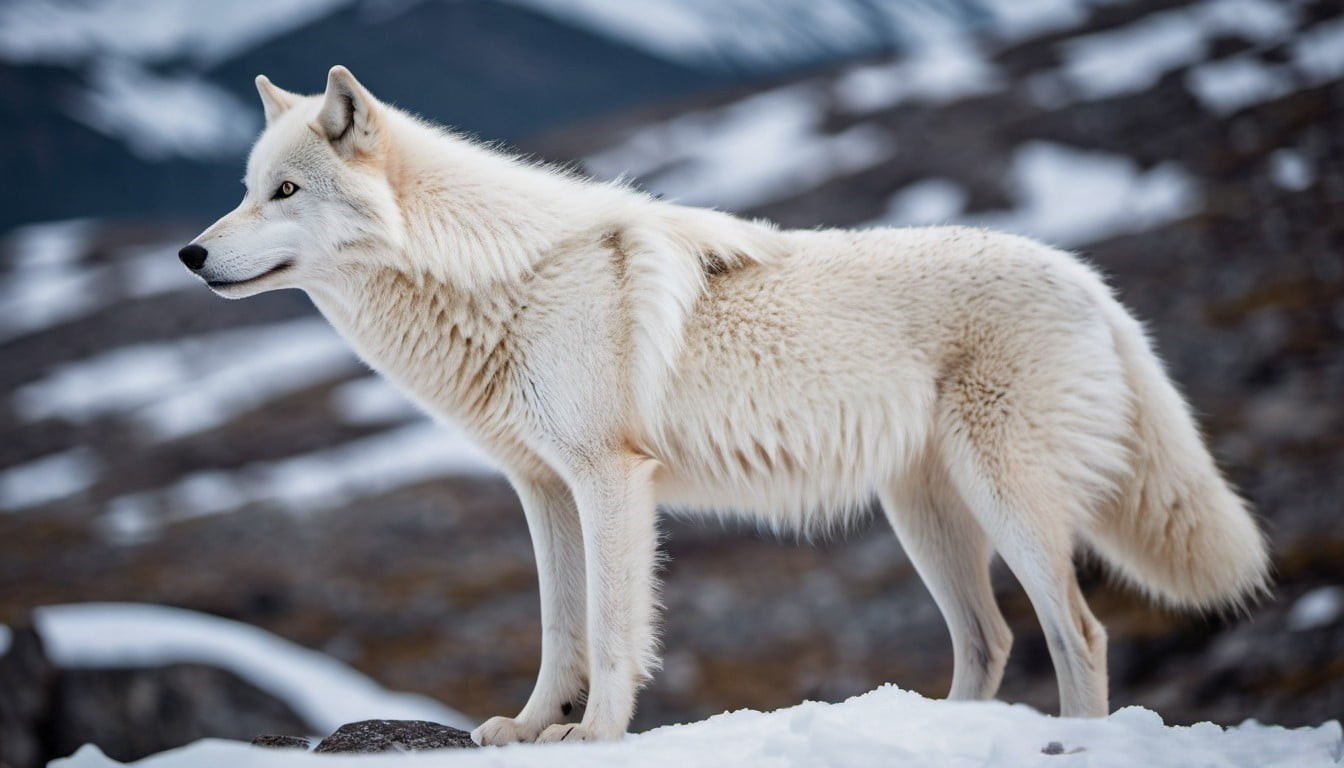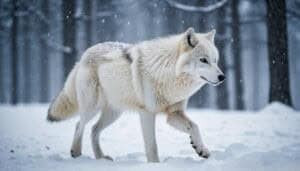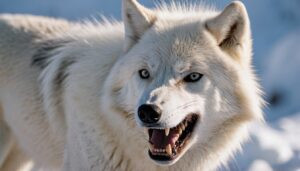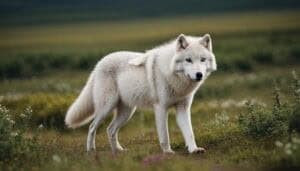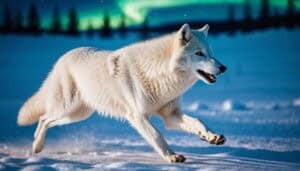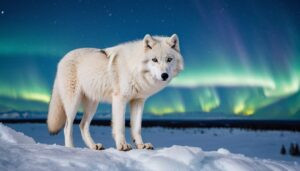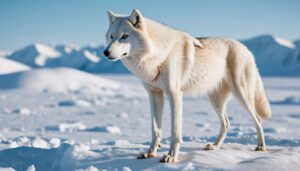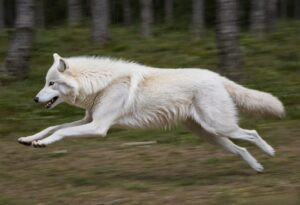Introduction
The Arctic wolf, known for its strength and resilience, owes much of its physical prowess to its unique muscle structure. This article delves into the specific muscles developed in the Arctic wolf, their role in hunting techniques, endurance, speed, agility, and pack dynamics
Additionally, we’ll explore how the Arctic wolf’s diet influences its muscle development. Understanding these aspects provides a comprehensive view of how muscle structure contributes to the Arctic wolf’s remarkable strength
Specific Muscles Developed in the Arctic Wolf
The Arctic wolf’s strength and agility are largely attributed to its well-developed muscle structure. These muscles are specially adapted to endure the harsh conditions of the Arctic and to perform critical survival tasks such as hunting and traversing rough terrain
Major Muscle Groups
The major muscle groups in the Arctic wolf include the muscles of the forelimbs, hindlimbs, and the core. Each of these groups plays a vital role in the wolf’s daily activities:
Forelimbs
The forelimbs of the Arctic wolf are equipped with strong muscles, including the biceps brachii, triceps brachii, and the brachialis. These muscles are crucial for powerful forward movements, allowing the wolf to pounce on prey and navigate through the snow
The shoulder muscles, such as the deltoids and pectorals, provide additional strength and stability, essential for climbing and maintaining balance on uneven terrain
Hindlimbs
The hindlimbs boast some of the most powerful muscles in the Arctic wolf’s body, including the quadriceps, hamstrings, and gluteals. These muscles are responsible for generating the thrust needed for running and leaping
The gastrocnemius and soleus muscles in the lower legs contribute to the wolf’s ability to make swift, agile movements and endure long-distance pursuits
Core
The core muscles, including the abdominals and the erector spinae, provide stability and support for the wolf’s spine. This strength is crucial for maintaining posture during sprints and for the overall coordination of the body
Comparison to Other Wolves
When compared to other wolves, the Arctic wolf shows some unique adaptations in its muscle structure:
Increased Muscle Mass
The Arctic wolf tends to have a more robust muscle mass compared to other wolf species. This increased muscle density helps in generating more power for movement and endurance, crucial for survival in the demanding Arctic environment
Adaptations for Cold Weather
The muscle fibers of the Arctic wolf are adapted to function efficiently in cold temperatures. This adaptation ensures that their muscles remain flexible and strong even in freezing conditions, unlike other wolves who may experience reduced muscle efficiency in such extreme cold
Enhanced Endurance
The Arctic wolf’s muscles are built for endurance. They can sustain prolonged physical activity, which is necessary for hunting over vast, open areas with scarce prey. This endurance surpasses that of many other wolf species that inhabit more temperate regions
Role of Muscle Strength in Hunting Techniques
The Arctic wolf’s muscle strength is integral to its survival, particularly in its hunting strategies. These wolves are known for their endurance and power, both of which are necessary for successful hunting in the harsh Arctic environment
Predatory Strategies
Stalking and Ambushing
The Arctic wolf utilizes its strong forelimb muscles to move stealthily through the snow. The biceps and triceps in the forelimbs allow for precise, controlled movements as the wolf approaches its prey quietly. This stealth is crucial for getting within striking distance without alerting the prey
Chasing and Pursuing
Once the prey is aware of the predator, the chase begins. The powerful hindlimb muscles, including the quadriceps and hamstrings, are vital for the high-speed pursuit. The gluteal muscles also play a significant role in providing the necessary propulsion for chasing down fast-moving prey such as caribou and hares
The Arctic wolf’s muscle strength allows it to sustain long chases over great distances, outlasting many of its prey who tire more quickly
Attacking and Bringing Down Prey
The shoulder and neck muscles are highly developed to deliver powerful bites. The deltoids and pectorals support the wolf in gripping and holding onto struggling prey. Additionally, the strong jaw muscles, including the masseter and temporalis, enable the wolf to deliver a fatal bite and secure its catch
Muscle Function During Hunts
Coordination and Agility
The coordination between various muscle groups allows for smooth and agile movements. The core muscles, particularly the abdominals and the erector spinae, provide the necessary stability for quick directional changes and sudden bursts of speed
Agility is essential during a hunt as the wolf often needs to maneuver quickly to avoid obstacles or to follow the erratic movements of its prey
Strength and Power
The overall muscle power of the Arctic wolf is crucial for taking down large prey. The combination of forelimb and hindlimb strength ensures that the wolf can deliver the necessary force to subdue its prey. The muscle structure supports not just speed but also the brute force needed in the final moments of the hunt
The wolf’s muscle strength also allows it to drag the prey back to its pack or a secure location, showcasing the importance of well-developed muscles in both the hunting and feeding processes
Endurance and Stamina
Hunts in the Arctic can be lengthy, requiring a great deal of stamina. The slow-twitch muscle fibers in the Arctic wolf are well-developed, enabling sustained physical activity over extended periods. This endurance is a crucial adaptation for hunting in an environment where prey can be scarce, and wolves must cover large distances to find food
The muscle endurance also aids in the recovery process, allowing the wolf to quickly regain strength and be ready for the next hunt
Muscle Structure and Endurance
The Arctic wolf’s muscle structure is finely tuned to support endurance, a critical trait for survival in the vast and harsh Arctic environment. Endurance is not just about sustained physical activity but also about the ability to maintain efficiency and strength over long periods in extreme conditions
Adaptations for Stamina
Slow-Twitch Muscle Fibers
Arctic wolves have a higher proportion of slow-twitch (Type I) muscle fibers compared to other wolf species. These fibers are more resistant to fatigue and are essential for sustained, long-distance travel. Slow-twitch fibers rely on aerobic respiration, which is more efficient for prolonged activity
These muscle fibers are particularly abundant in the wolf’s legs and core, supporting the long treks often required to track down prey over the Arctic tundra
Efficient Oxygen Use
The Arctic wolf’s muscles are adapted to use oxygen more efficiently, a necessity for maintaining endurance in cold environments where energy expenditure is high. The capillary density in their muscles is greater, facilitating better oxygen delivery to the muscle tissues
This efficient oxygen use is crucial during long hunts and when covering large territories, enabling the wolf to sustain physical activity without quick exhaustion
Fat Storage and Utilization
The Arctic wolf’s muscle tissue can store and utilize fat more effectively. Fat is a dense source of energy, and the ability to metabolize fat efficiently helps in maintaining endurance during long periods between meals
This adaptation ensures that the wolf can survive extended periods of scarcity, a common scenario in the Arctic, by relying on stored energy reserves
Cold Climate Survival
Muscle Function in Freezing Temperatures
The muscle fibers of the Arctic wolf are adapted to remain functional even in sub-zero temperatures. These adaptations include better blood flow and cellular mechanisms that prevent the muscles from freezing or becoming too stiff to function effectively
The combination of strong muscles and efficient blood circulation ensures that the wolf can maintain its physical capabilities in freezing conditions, which is crucial for hunting and traveling
Thermoregulation
The muscle activity in Arctic wolves also contributes to thermoregulation. As muscles contract during movement, they generate heat, which helps maintain the wolf’s core body temperature. This internal heat generation is essential for survival in the frigid Arctic climate
The wolf’s thick fur provides insulation, but the heat generated by muscle activity is a significant factor in preventing hypothermia during long hunts or periods of rest
Energy Conservation
Arctic wolves have evolved to conserve energy efficiently. Their muscle structure supports a balance between bursts of high-intensity activity and periods of rest. This energy conservation is critical for maintaining endurance over the long term
During periods of inactivity, the wolf’s metabolism slows down, reducing the energy required to maintain muscle function. This adaptability allows the wolf to sustain its strength and stamina even with limited food intake
Impact on Speed and Agility
The Arctic wolf’s muscle structure significantly contributes to its speed and agility, essential traits for survival in the rugged and expansive Arctic terrain. These attributes enable the wolf to hunt effectively, escape from potential threats, and navigate its environment with ease
Muscles Involved in Movement
Hindlimb Muscles
The powerful muscles of the hindlimbs, such as the quadriceps and hamstrings, are crucial for generating the force required for rapid acceleration and sustained running. The gluteal muscles further enhance this power, providing the thrust needed for high-speed pursuits
The gastrocnemius and soleus muscles in the lower legs contribute to the wolf’s ability to make quick, explosive movements. These muscles support the wolf’s agility, allowing for sharp turns and sudden directional changes
Forelimb Muscles
The forelimb muscles, including the biceps brachii, triceps brachii, and brachialis, play a key role in maintaining balance and stability during movement. These muscles are vital for coordinating the wolf’s strides, ensuring smooth and efficient locomotion
The shoulder muscles, particularly the deltoids and pectorals, provide additional support for fast, agile movements, enabling the wolf to navigate through dense snow and over uneven terrain
Core Muscles
The core muscles, comprising the abdominals and the erector spinae, offer stability and support to the entire body during movement. These muscles help maintain posture and balance, crucial for the wolf’s agility and coordination
A strong core allows the wolf to transfer energy efficiently between the forelimbs and hindlimbs, enhancing overall speed and agility
Performance in Different Terrains
Snow and Ice
The Arctic wolf’s muscle structure is adapted to perform efficiently on snow and ice. The well-developed muscles in the legs provide the strength needed to move through deep snow, while the claws offer additional grip on icy surfaces
The muscles support a high step gait, preventing the wolf from sinking too deeply into the snow and allowing for faster, more efficient travel across snowy landscapes
Rocky and Rugged Terrain
In rocky and uneven terrains, the wolf’s agility and balance are paramount. The muscle strength in the forelimbs and hindlimbs, combined with a strong core, allows the wolf to navigate steep inclines and rocky outcrops with ease
The ability to make quick, precise movements is essential for maintaining stability and avoiding injury on such challenging terrain
Open Plains
On open plains, where speed is often more critical than agility, the Arctic wolf’s powerful hindlimb muscles come into play. These muscles enable the wolf to achieve high speeds over long distances, necessary for chasing down fast-moving prey
The forelimbs and core muscles help maintain balance and coordination during these high-speed pursuits, ensuring that the wolf can sustain its speed without losing control
Primary Functions of Leg Muscles
The leg muscles of the Arctic wolf are central to its overall physical capabilities, particularly in running, leaping, and traversing rough terrain. These muscles provide the necessary strength and flexibility to navigate the challenging Arctic environment
Running and Leaping
Running
The Arctic wolf’s running ability is primarily supported by the powerful muscles in its hind legs. The quadriceps, located at the front of the thigh, are key to extending the leg and propelling the wolf forward with each stride
The hamstrings, situated at the back of the thigh, work in conjunction with the quadriceps to flex the leg during the running cycle. This coordination allows for smooth, efficient movement and sustained speed over long distances
The calf muscles, particularly the gastrocnemius and soleus, provide the force necessary for pushing off the ground. This muscle group is crucial for maintaining high speeds, especially during long chases in pursuit of prey
Leaping
Leaping is another critical aspect of the Arctic wolf’s mobility, particularly when hunting or navigating obstacles. The gluteal muscles in the hips are highly developed and provide the explosive power required for jumping
The quadriceps and hamstrings again play significant roles in this action, working together to extend and flex the leg, giving the wolf the ability to leap high or far distances as needed
The flexibility and strength of the ankle muscles, including the tibialis anterior and the calf muscles, also contribute to the wolf’s ability to land gracefully and absorb the impact of a jump
Traversing Rough Terrain
Adaptation to Varied Landscapes
The Arctic wolf’s leg muscles are adapted to handle the varied and often rough terrain of the Arctic. The muscles must provide stability and balance on uneven ground, such as rocky outcrops, frozen rivers, and dense snowdrifts
Strong stabilizing muscles, like the adductors and abductors located in the inner and outer thighs, help the wolf maintain balance while walking or running on sloped or unstable surfaces
Climbing and Descending
Climbing steep inclines and descending rocky slopes require significant muscle control and strength. The muscles of the hind legs, especially the gluteals and hamstrings, are engaged to pull the wolf upwards or control its descent
The forelimb muscles, including the biceps, triceps, and brachialis, assist in pulling the body forward during a climb and in providing stability when descending
Agility in Dense Snow
Navigating through dense snow requires the Arctic wolf to lift its legs higher than usual, engaging the hip flexors and thigh muscles more intensely. The quadriceps and hip flexors work to raise the legs, while the hamstrings and gluteals provide the strength to push through the snow
The leg muscles must also work harder to prevent the wolf from getting stuck, demonstrating their importance in mobility and endurance in such challenging conditions
Influence of Muscle Structure on Pack Dynamics
The Arctic wolf’s muscle structure plays a significant role in its social interactions and pack dynamics. The strength and agility provided by these muscles influence the physical hierarchies within the pack and contribute to cooperative hunting strategies
Physical Hierarchies
Dominance and Rank
Within a wolf pack, physical strength often determines rank and dominance. The alpha wolf, typically the strongest and most muscular, leads the pack and maintains order. The well-developed muscles of the alpha allow it to assert dominance over other pack members, ensuring its leadership position
Muscle structure not only indicates physical prowess but also contributes to the wolf’s ability to perform essential leadership functions, such as leading hunts and defending the pack
Challenges and Fights
Challenges for dominance are common in wolf packs. The strength and muscle structure of a wolf can determine the outcome of these contests. A wolf with more developed muscles, especially in the forelimbs and hindlimbs, is likely to overpower a weaker opponent, thereby securing or improving its rank within the pack
The muscle strength in the jaw and neck also plays a crucial role during fights, allowing wolves to deliver powerful bites and withstand attacks
Social Play and Training
Younger wolves engage in social play that often mimics the actions of hunting and fighting. This play is essential for developing muscle strength and coordination. Through play, juvenile wolves build the muscle structure necessary for their future roles within the pack
The development of muscles during these interactions prepares younger wolves for the physical demands of adulthood, including challenges for rank and participation in hunts
Cooperative Hunts
Roles in Hunts
The muscle structure of each wolf influences its role during a hunt. Stronger wolves, often the alphas and betas, take on roles that require significant strength, such as tackling and bringing down large prey. Their powerful leg and core muscles enable them to deliver the necessary force to subdue their targets
Wolves with a lighter build and greater agility, supported by well-developed leg and core muscles, may take on roles as chasers or flankers, driving prey towards the stronger wolves for capture
Team Coordination
Successful hunts require precise coordination and teamwork, relying heavily on the muscle strength and endurance of all pack members. The ability to maintain speed and agility over long distances is crucial for the chase, while strength is needed to tackle and immobilize prey
The pack’s muscle structure allows for dynamic interactions during a hunt, with each wolf leveraging its physical capabilities to contribute to the pack’s success
Carrying and Sharing Prey
After a successful hunt, the pack must transport the prey to a safe location for consumption. The muscle strength of the pack members is essential for dragging or carrying large prey over potentially long distances. This task requires significant endurance and coordination
The ability to share and distribute the prey efficiently among pack members, especially to the weaker or younger wolves, ensures the survival and health of the entire pack
Diet and Muscle Development
The Arctic wolf’s diet plays a crucial role in muscle development and overall physical health. A nutrient-rich diet ensures that these wolves maintain the strength and endurance necessary for survival in the harsh Arctic environment
Nutritional Needs
Protein Intake
Protein is the most vital component of the Arctic wolf’s diet. It is essential for muscle growth, repair, and maintenance. The primary source of protein comes from the prey they hunt, such as caribou, muskoxen, Arctic hares, and lemmings
The consumption of protein helps in building and maintaining strong muscle fibers, which are crucial for the wolf’s strength and hunting efficiency. A high-protein diet supports the development of both fast-twitch and slow-twitch muscle fibers, enhancing speed, power, and endurance
Fat Content
Fat is another significant part of the Arctic wolf’s diet, providing a dense source of energy. The fat content in their prey helps sustain their energy levels, especially during long hunts and in between meals when food is scarce
Fat is stored in the wolf’s body and utilized as a secondary energy source. This stored energy is particularly important during the harsh winter months when prey is less abundant, helping the wolf maintain muscle mass and overall health
Vitamins and Minerals
The Arctic wolf’s diet includes vital vitamins and minerals necessary for muscle function and overall well-being. Calcium and phosphorus, derived from the bones of their prey, are crucial for bone health and muscle contraction
Other essential nutrients, such as iron and B vitamins, support oxygen transport and energy metabolism, enhancing muscle performance and endurance
Diet’s Role in Muscle Growth
Hunting Success and Muscle Development
The Arctic wolf’s ability to develop and maintain strong muscles is directly linked to its hunting success. Regular access to nutrient-rich prey ensures continuous muscle growth and repair
Wolves that are more successful hunters typically exhibit better muscle development, as their diet provides the necessary nutrients to support muscle hypertrophy and strength
Impact of Prey Scarcity
During periods of prey scarcity, the Arctic wolf’s muscle development can be compromised. Limited food intake leads to muscle catabolism, where the body breaks down muscle tissue for energy. This can result in decreased muscle mass and strength
However, the wolf’s ability to store fat and utilize it during lean times helps mitigate muscle loss, allowing them to maintain a certain level of muscle mass and endurance until prey becomes more available
Feeding Hierarchies
Within the pack, feeding hierarchies influence individual wolves’ access to food. Alpha wolves typically eat first, ensuring they receive the best portions, rich in protein and fat. This preferential access supports their muscle development and maintains their dominant status
Subordinate wolves may have less consistent access to high-quality food, which can impact their muscle growth and overall health. However, the pack’s cooperative hunting strategies ensure that most members receive enough nutrients to survive and develop adequately
Growth and Development in Pups
For Arctic wolf pups, proper nutrition is critical for muscle development and growth. Initially, they rely on their mother’s milk, which is rich in fat and protein, essential for early development
As they transition to solid food, the quality of their diet continues to play a crucial role in developing strong muscles. Access to nutrient-dense prey ensures that pups grow into strong, capable adults, ready to participate in hunts and contribute to the pack
Conclusion
The Arctic wolf’s muscle structure is a vital component of its survival in the harsh Arctic environment. This article explored various aspects of how the wolf’s muscles contribute to its strength and functionality
Firstly, we examined the specific muscles developed in the Arctic wolf, noting the importance of major muscle groups such as the forelimbs, hindlimbs, and core. These muscles are more robust compared to other wolf species, allowing for increased power and endurance
Secondly, we discussed the role of muscle strength in hunting techniques, highlighting the importance of forelimb and hindlimb muscles in stalking, chasing, and capturing prey. The coordination and strength provided by these muscles ensure successful hunts, which are critical for the wolf’s sustenance
Next, we explored how the muscle structure supports the wolf’s endurance, focusing on adaptations like slow-twitch muscle fibers, efficient oxygen use, and fat utilization. These adaptations enable the wolf to maintain prolonged physical activity in freezing temperatures
The impact of muscle structure on speed and agility was also examined, detailing how powerful hindlimb and forelimb muscles, along with a strong core, allow the wolf to navigate various terrains efficiently. This agility is crucial for both hunting and evading threats
The primary functions of leg muscles were discussed, emphasizing their role in running, leaping, and traversing rough terrain. These muscles provide the necessary power and flexibility for the wolf to move through deep snow, climb steep inclines, and maintain balance on uneven ground
We then looked at the influence of muscle structure on pack dynamics, explaining how physical strength determines rank and dominance within the pack. Cooperative hunts benefit from the diverse muscle strengths of pack members, ensuring effective prey capture and distribution
Finally, we explored the role of diet in muscle development. A nutrient-rich diet, high in protein and fat, supports muscle growth, repair, and energy metabolism. The availability of prey directly impacts muscle development, with successful hunters typically exhibiting better muscle condition
